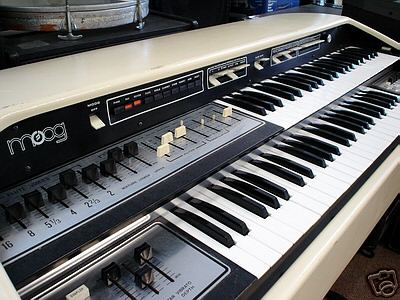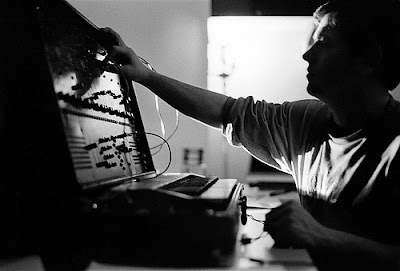 Click here
Click here for shots via
this auction
Some details:
"Moog Cordovox White Elephant Electric Organ, model CDX-0652. I believe that these were made from 1975-79.
from
Synthmuseum.com:
The Moog Satellite was designed to be an organ player's synth. It was manufactured by the Thomas Organ Company, who paid a large royalty to be allowed to manufacture the Satellite for Moog. In return they were allowed to incorporate the Satellite into their organs. Thomas Organ Company also, along with Cordovox, designed the Moog CDX.
The Moog CDX is basically a Cordovox organ with a built in Satellite monosynth. It is the only organ product that bears the Moog name prominently across the front. Somewhat rare in the US, they seem to be in plentiful supply in parts of europe.
from
combo-organ.com: CDX-0652
A dual-manual combo organ with a Moog Satellite grafted onto it. I understand that the Satellite had a very thin sound, nothing like the MiniMoog. It had only a single oscillator and several preset sounds, similar to other semi-preset synths like the Arp Pro Soloist and the Roland SH-2000.
Thomas bought the rights to the Satellite from Moog. The CDX-0652 was designed by Thomas in cooperation with Cordovox. A Thomas version of the Satellite (the "Synthi 1055) and the CDX-0652 were both manufactured by EME, the same outfit that made most Italian Vox organs. Thomas also marketed the Satellite under the "Orbit" name on some of their home organs.
The synthesizer voices play only on the upper manual, organ voices play on both. Organ and synth voices may be played simultaneously on the upper manual. It includes a batch of 9 preset synthesizer voices that don't appear on a Satellite. Unlike the 0642, this one seems to have all of the organ features (many of which seem identical to the 0642) available on both keyboards.
Controls:
Top Panel:
* Tab: Moog On/Off
* Buttons: Piano, Sax, Guitar, Flute, Banjo, Clarinet, String, Trumpet, Horn, Preset
* *Tabs 1: Octaves: 1 & 2 Modulation: Rep, Sine/Square, Vib, Trem
* *Tabs 2: Glide, Sust
* *Tabs 3: Brass: Mute, Open Reed: Thin, Hollow, Full, Bright
* *Tabs 4: String: Bow, Pluck Strike, Pick Bell, Lunar
Left of Upper Keyboard:
* Knob: Tuning
* Black Sliders: Flute Voices: 16', 8', 5-1'3, 4', 2-2'3, 2' Mixture, Volume Lower, Volume Upper
* *White Sliders: Filter: Contour, Color, Emphasis Modulation: Rate, Depth Glide, Volume
Left of Lower Keyboard:
* Buttons: Coupler, Sustain, Bass
* Sliders: Bass Min/Max, Guitar Bass, Vibrato Depth
Right of Lower Keyboard:
* Buttons: Percuss, Repeat, Mono
* Sliders: 8', 4', 2-2/3', 2', Decay Short/Long, Repeat Rate Slow/Fast"
via Johan
 flickr by scose.
flickr by scose.
 flickr by scose.
flickr by scose. Remember Mimi? Here's a shot of her with a Polivoks. Via catsynth.com where you will find one more shot.
Remember Mimi? Here's a shot of her with a Polivoks. Via catsynth.com where you will find one more shot. via Mark:
via Mark: flickr by fonik2000.
flickr by fonik2000.











